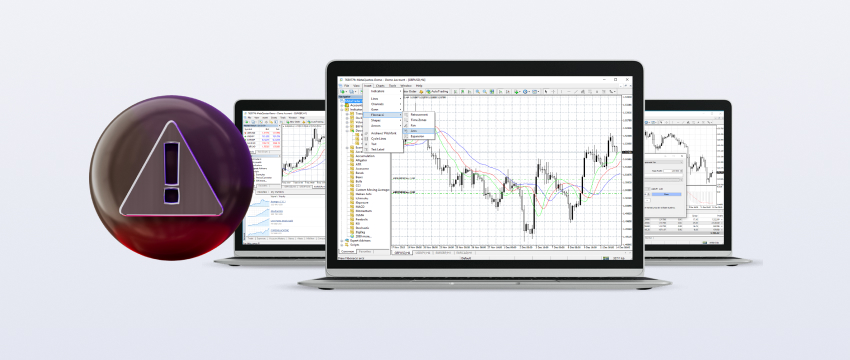MetaTrader 4 is one of the most common trading tools in the forex and CFD space. Most traders start their journey on it, and many stick with it for years, often making avoidable MT4 mistakes along the way.
What allows this approach is MT4’s simultaneous ease and depth of use. The interface is dated, yes, the software came out 15 years ago.
However, that’s more on the visual side. Usability-wise, it’s one of the most intuitive trading platforms out there, with simple navigation, apparent functions, and a ton of features to keep new users safe.
On the other side, it’s far from a beginner-only tool. It has 30 built-in indicators, allowing for some depth out of the box. However, where things really get interesting is when you dive into the vast world of custom tools for MT4.
EAs, backtesting, chart customisation, proprietary indicators, and much more are available from various sources online. Techies can even create their own with the MQL4 programming language.
However, the combination of these two aspects also means that it’s easy for new traders to make mistakes. And without proper guidance, these MT4 mistakes can become ingrained in your trading instinct and become a permanent habit.
This article will outline the five most common MT4 mistakes traders make on MT4 and how to deal with them.
5 most common MT4 mistakes traders
1: Overloading on Indicators
Indicators are the bread and butter of many traders’ routines. They allow traders to get a clearer view of the markets, spot opportunities, and better understand what’s going on. Of course, many people’s gut instinct says that more indicators = better.
However, this can cause a lot of problems. The first is related to the platform itself. Even if MetaTrader 4 isn’t performance-intensive, indicators can quickly burden your device and slow down the platform. If paired with multiple screens and a dated device, this can affect the speed at which the platform runs significantly.
Of course, this then leads to missing trade timings, and in forex, where every pip matters, this negative impact accumulates faster than you’d think. This effect is even more prominent with fast-paced trading strategies like scalping and day trading.
The other most significant downside is for the trader themselves. Adding too many indicators can actually reverse their effect, creating clutter and making trading data harder to read. It’s difficult to make the right decision with ten different indicators flashing in your face.
Solving this is fairly simple: consider the strategy you are using, and include only indicators that directly help you execute it. Start small and add gradually, until you’ve hit the sweet spot.
2: Ignoring Risk Management Tools
New traders are often only interested in how to win, not how to prevent losses. However, in the trading world, balancing these two properly is the only way to achieve consistency.
Risk management is a key part of trading, and while it doesn’t pertain to MT4 directly, the platform does offer tools to help with it. As such, ignoring these tools can deteriorate performance and make it much harder for traders to get anywhere.
So what does risk management mean in the context of MetaTrader 4?
There are three key aspects:
- Uncontrolled losses
- Missed profits
- 情绪交易
And while each of these could easily be an article of their own, let’s do a short rundown.
Uncontrolled losses happen when measures aren’t set in place to close trades before they go extremely sour. Imagine you’re at your platform and you go brew yourself a coffee or answer the door. In the few minutes you’re away, your open positions can shift dramatically, and without the proper mechanisms in place, can cause significant losses.
Stop losses deal with this, and close trades when they reach a certain level. Learning where to set stop losses and placing them on every trade is a good habit for everyone, especially new traders.
Missing profits is a bit of a different story, and it’s usually driven by greed. Traders see that a position is going well and simply don’t want to get out. The position then reverses, and traders either gain much less than they could’ve or even mark a loss.
Take profits are the tool to use here. They set a profit point where trades will close automatically, allowing traders to plan ahead instead of getting swept up in the moment.
Finally, emotional trading involves greed, fear, and actions such as chasing losses. Again, take profits and stop losses help with this, since they take emotions out of the equation.
One note here is that risk management tools aren’t enough. Traders need to recognise and control these behaviours if they want to erase them completely.

3: Not Using Demo Accounts
Demos on MetaTrader 4 are an extremely powerful tool. They can help traders grasp the basics of the platform, as well as the essentials of trading itself. The best part, they are completely free.
Brokers who provide demo accounts usually give traders a set amount of virtual funds that they can use at their leisure. With these, traders can simulate a real trading environment and easily test their strategy, play around, and see how different trading situations would play out.
The difference is that demos don’t have the same emotional charge, but traders who keep that in mind can get a lot of mileage out of them.
However, most traders are overly eager to get to live trading and skip this step. As such, they go in either not fully grasping MT4 or with insufficient experience in trading.
This can harm their performance significantly, as they are unable to react quickly to unforeseen situations, or simply have to work much more to achieve the same results as someone who’s comfortable in the platform.
The fix is simple, if you’re not yet fully comfortable in MT4, find a broker who offers a demo (preferably the one you intend to use for live trading), and spend some time learning the ins and outs.
4: Overleveraging
Again, this is not directly tied to MT4, but most MT4 brokers do offer leverage. Leverage, or margin trading, allows traders to multiply the size of their positions. Of course, this also multiplies wins and losses.
It’s an alluring proposition, and it’s no surprise a lot of traders get carried away. Alternatively, some who aren’t familiar with MT4’s interface can accidentally set leverage too high. This is by far the most common new trader MT4 mistake, so it’s crucial to avoid it.
- Do not risk too much of your total capital on a single leveraged trade (1-2% is generally recommended)
- Start with low leverage and move up gradually
- Always check if your leverage is at the level you want
5. Not maintaining your MT4 is a common mistake
The final MT4 mistake is a basic one, but one that can cost you. It’s failing to update the MetaTrader 4 platform properly. Both the platform and the brokers that provide servers for it release regular updates.
Not tracking these and updating regularly can lead to crashes, performance issues, execution delays, and general incompatibility.
The solution, of course, is to stay informed on the latest updates and make sure to download and install them regularly.
We’ll wrap up with one final tip for traders who want to take this a step further. For those who want to ensure their MT4 platform always runs with near-perfect latency, VPS servers are an option. This is most commonly, however, a paid service, so it’s wise to weigh the potential upside against the cost.

Conclusion: Avoiding common MT4 Mistakes and getting the most out of the platform
MetaTrader 4 is more than just a trading platform; it’s a tool that can make or break your trading journey, depending on how you use it.
The common mistakes traders make, from overloading indicators to ignoring risk management, skipping demo accounts, overleveraging, or neglecting updates, aren’t just technical slip-ups, they’re habits that can quietly erode your success over time.
The key is to approach MT4 with both discipline and curiosity, keep learning, keep testing, and keep refining your strategy. When used thoughtfully, MT4 isn’t just a starting point, it can become a powerful foundation that supports smarter, more consistent trading for the long haul.
免责声明: This material is for general informational and educational purposes only and should not be considered investment advice or an investment recommendation. T4Trade is not responsible for any data provided by third parties referenced or hyperlinked in this communication.




